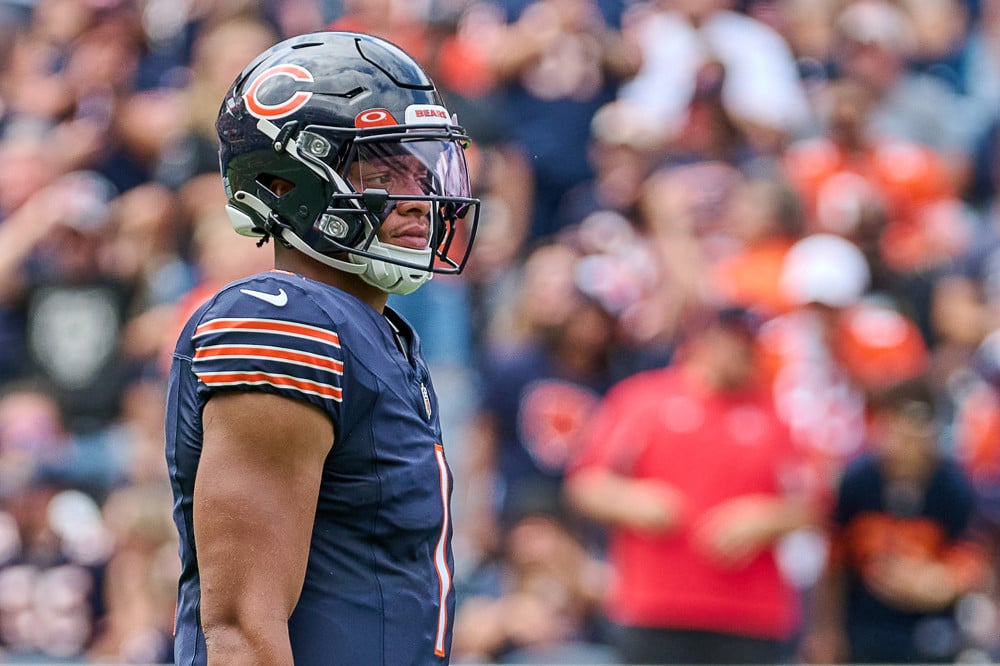Editor’s Note: Our In-Season Product contains everything you need to win at NFL DFS. It’s $229.99 for 22 weeks of coverage. For more details, head here.
Editor’s Note 2: If you want to use an optimizer for NFL DFS this season, we recommend The Solver. Use this link to sign up and if you have ETR In-Season, our projections and ownership will auto-sync in the Solver optimizer.
You want to win $1 million playing fantasy football? So do I.
DraftKings’ weekly NFL Milly Maker remains the flagship DFS tournament. It’s a unique contest because it often has more than 200,000 entries, roughly 30% of the prize pool goes to first place, and someone becomes a millionaire off a $20 buy-in.
This “put up a little to win a lot” model is always going to be incredibly popular. It attracts tons of unsophisticated and casual players, making the Milly Maker a very +EV tournament for thoughtful and sharp players. Of course, we need to be aware that realizing the positive expectation is very difficult at these massive field sizes.
So how do we win it? By picking the right players, dummy! Of course, that is first-level thinking and not a real or thoughtful strategy. We are not nearly as good at picking the “right” players as we think we are. So while much of the field is just selecting players they like, we need to optimize for first place through other strategies.
That means thinking about lineup construction, salary allocation, flex usage, correlation, ownership leverage, and more. If we can understand what wins this tournament, we can build a repeatable process that raises our chances of shipping.
The data you see below was compiled by Mike Leone, our Director of Analytics.
WHAT WE FOUND
1. Double stack our quarterback with WR-WR
“Double stack” means rostering a QB with exactly two of his teammates at any position. For example, Joe Burrow with Ja’Marr Chase and Tee Higgins. Or Jordan Love with Christian Watson and Jayden Reed. Even though it’s smaller than it used to be, we still gain the most leverage on the field with this construction.
Single stacks (a QB with one pass catcher) are a roughly neutral bet. Naked QB (no pass catchers) is a losing bet. Stacking QB with RB is a slightly losing bet, but that is likely because the field isn’t thoughtful with which RBs can be part of a stack. There’s a big difference between Brock Purdy–Christian McCaffrey, and Ryan Tannehill–Derrick Henry. The Purdy stack is far better as he projects for 5+ targets weekly.
Data: The field stacks a QB with TWO WRs roughly 13% of the time. But top-100 lineups do it 19% of the time.
2. Use TE as a “bring-back” in double stacks more often
Tight end is the lowest-floor position in fantasy. That is partially because most tight ends see limited volume, and therefore become touchdown-dependent.
So it makes a ton of sense that tight ends would be dragged along in successful game stacks. We need the game to be high-scoring, and tight ends can outperform their touchdown expectation in those environments.
An example of this would be if the Eagles were playing the Bucs. The tight end “bring-back” would be Cade Otton on the other side of a Jalen Hurts–A.J. Brown–DeVonta Smith double stack.
Data: Over the last three years, bring-back tight ends have been used 34% more frequently on top-100 teams.
3. Triple stacks are viable
Playing a QB with three of his teammates (WR, RB, or TE) is a bit counterintuitive. How can there be enough fantasy points to go around?
Of course, on most slates, we need a top .1% outcome from the QB of our stack just to have a chance. And in those outcomes, we can put ourselves in a position to beat a monster field. Just be aware that this structure will lead to plenty of airballs — the idea is to ignore that and focus on what we do win when we win.
Data: In 2022, the field played triple stacks 4.3% of the time. But top-100 teams did it 7.7% of the time.
4. Use RB or WR in FLEX
DraftKings made pricing much tighter in 2022, especially at wide receiver. And the 2021 move to a $4,000 RB salary floor also made things tight. That’s led to the field using tight end in the FLEX as a salary-saver at an extremely high rate. Of course, the floor/ceiling combos on tight ends (especially cheap ones) are painful.
Data: The field used TE in FLEX a whopping 19% of the time in 2022, the highest rate in the last three years. But top-100 teams stayed at 12%, the same rate as 2021.
5. Use all or most of your salary cap
Leaving salary space on the table is not the way to get unique. It causes us to lose too much equity in projection. Note that in 2022 the field used an average of $49,877 of their $50,000 cap and top-100 teams were at $49,893.
6. Lean toward spending up at WR
DraftKings features full-PPR scoring with a bonus for 100 yards rushing or receiving. This format lends itself to WR-heavier lineups for tournaments because the position has the most volatility.
It’s not a big edge, but top-100 teams are spending slightly more than the field at WR. And they’re also spending slightly less at RB than the field.
Expanding on that, over the last two years, top-100 teams on average have rostered 1.30 high-priced WRs per lineup. The field has rostered 1.20. (We define “high-priced WR” as those priced $6,500 or higher on DraftKings.)
7. Use more players in the 5-15% owned bucket
Top-100 teams have meaningfully lower product ownership than field teams. Product ownership can be found by multiplying together each player’s ownership. That’s different than cumulative ownership, which adds up each player’s ownership.
For example, what’s a better lineup: One with three guys each at 20% owned, or one with 8%, 32%, and 20% owned players? They each have a cumulative ownership percentage of 60%, but the product ownership on the latter set is far lower.
Top-100 teams use more players in the 5-15% owned bucket. And fewer in the 40+% owned bucket. That creates lower product ownership.
Note that top-100 teams and the field had roughly the same cumulative ownership in 2022.
8. Use our projections (shout-out to us)
Our projections are significantly better than the field. We have proof! By comparing our projections’ salary-based value to actual ownership, we can see how much stronger our projections are:
At quarterback, our projected value (salary-adjusted) has a 0.58, 0.58, and 0.62 correlation to actual value over the last three seasons. Ownership value (what the field did) had a 0.44, 0.29, and 0.42 correlation to actual value over the last three seasons.
At running back, our projected value (salary-adjusted) has a 0.52, 0.55, and 0.55 correlation to actual value over the last three seasons. Ownership value (what the field did) had a 0.33, 0.37, and 0.39 correlation to actual value over the last three seasons.
At wide receiver, our projected value (salary-adjusted) has a 0.41, 0.41, and 0.44 correlation to actual value over the last three seasons. Ownership value (what the field did) had a 0.22, 0.29, and 0.30 correlation to actual value over the last three seasons.
At tight end, our projected value (salary-adjusted) has a 0.37, 0.41, and 0.41 correlation to actual value over the last three seasons. Ownership value (what the field did) had a 0.22, 0.29, and 0.29 correlation to actual value over the last three seasons.



